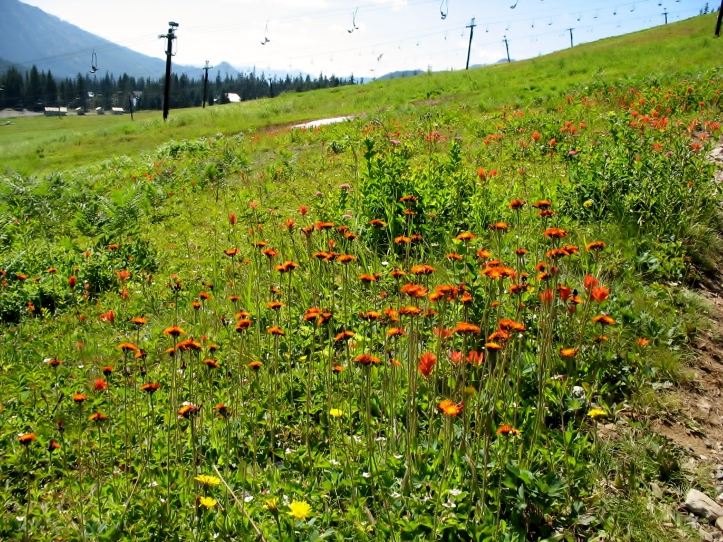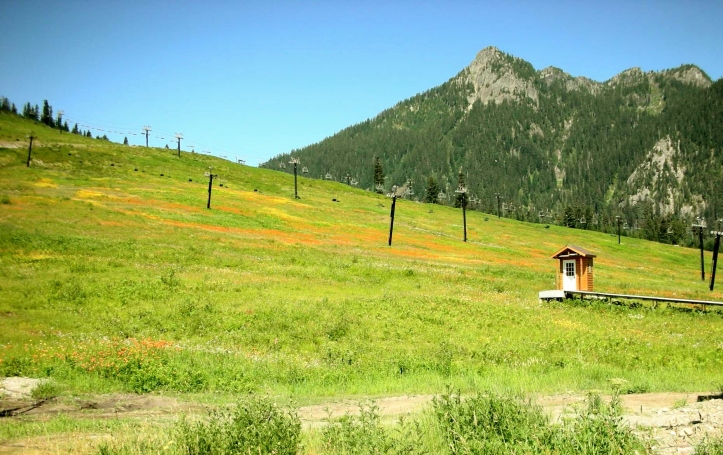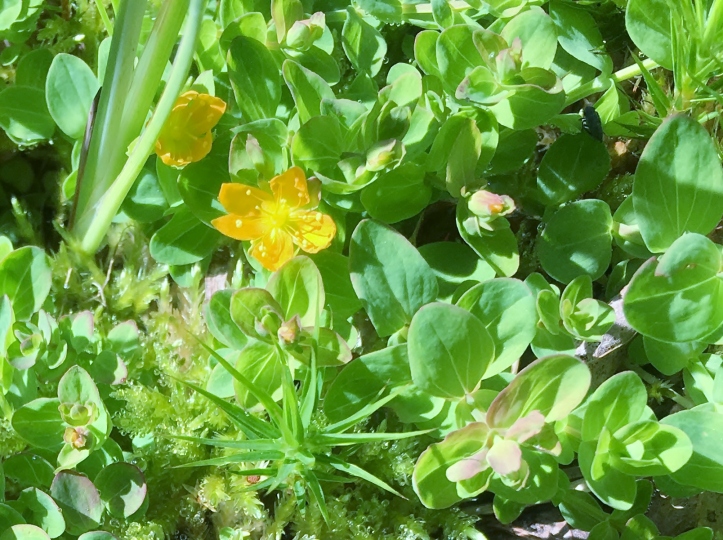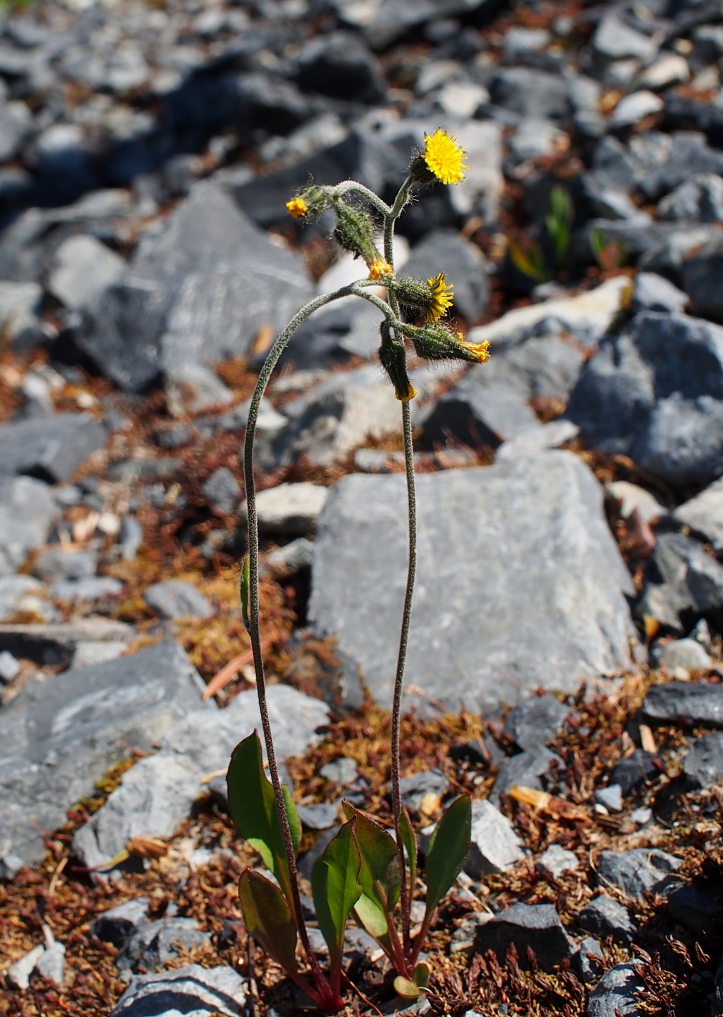
Invasive plants are a menace for a lot of reasons: They can cause serious harm to humans and animals; lower farmers’ crop yields; damage the mountains and lakes we love to visit, cutting back the tourism revenue for surrounding communities; and inflict many other kinds of destruction. They also displace many of the incredible (sometimes rare) native plants that grow in our region. By controlling invasive weeds, we help our remarkable natives regain a foothold in King County.
Earlier this month, I had a chance to see this rebirth in action when I traveled out to Alpental with Weed Specialists (and botanists extraordinaire) Matt Below and Patrick Sowers. For more than a decade, our program has worked to eradicate two highly invasive perennials, orange hawkweed (Hieracium aurantiacum) and yellow hawkweed (Hieracium caespitosum) from the Alpental and Snoqualmie Ski areas at Snoqualmie Pass. Originally from Europe, these plants outcompete native plants and form dense monocultures in disturbed areas, forests, and meadows. They’re especially concerning because they can invade meadows at higher elevations, displacing the native plants there.

Orange and yellow hawkweed can be identified by their hairy, unlobed basal leaves; black, ball-shaped buds in tight clusters on hairy, almost leafless stems 1 to 3 feet tall; yellow or orange flower heads; fuzzy white stolons when flowering; dandelion-like seed heads; and a milky juice inside all plant parts.
Over the years, our program has made a big impact on Snoqualmie Pass’ invasive hawkweed population. For instance, here are two before and after photos of the Summit at Snoqualmie, the latter taken during our visit:


This trip, the landscape was a far cry from the dense swathes of orange you see in the 2009 photo. Throughout the day, we found only smaller, scattered patches of invasive hawkweeds across the slopes. Instead, we discovered something far more interesting and uplifting: a phenomenal display of native plants!
Climbing a ski run at Alpental, we quickly came across a population of round-leaved sundew (Drosera rotundifolia). This tiny perennial supplements its soil nutrients by eating insects. Drawn to the sugary beads at the end of the sundew’s tentacles, the insects become trapped and the plant dissolves them.

Growing among the round-leaved sundew, we also found a population of bog St. John’s-wort (Hypericum anagalloides), a low-growing perennial that’s native to western North America. “The Latin hypericum means ‘above pictures,’ from the early placement of plants over shrines to repel evil spirits,” write Jim Pojar and Andy MacKinnon in their Plants of the Pacific Northwest field guide. This wonderful little bog plant is totally different from the invasive common St. Johnswort (Hypericum perforatum), a noxious weed introduced from Europe.

A bit farther up, we stumbled across our second carnivorous plant, common butterwort (Pinguicula vulgaris). This perennial eats its insects by trapping them on its sticky leaves, after which the leaves roll up and the plant dissolves its victims. Butterwort gets its name because it “supposedly encouraged or protected the productivity of milk cows, ensuring a supply of butter,” write Pojar and MacKinnon.


Combing the slopes for the (largely absent) invasive hawkweeds, we also discovered two native hawkweeds. The first, white-flowered hawkweed (Hieracium albiflorum), looks similar to the two invasive hawkweeds but is a generally more slender plant with (as the name implies) white flowers. The second, slender hawkweed (Hieracium triste or Hieracium gracile), is a slight, yellow-flowered hawkweed with usually hairless basal leaves. Native and non-native hawkweeds do interbreed when their ranges overlap, which can make identification difficult.


Elsewhere in the Snoqualmie Pass area, on roadsides and forest edges, you can find a number of other delightful native plants. For instance, the rare Washington springbeauty (Claytonia washingtoniana), native to the western United States and British Columbia, blooms just off of Denny Creek Road.

Jeffrey’s shootingstar (Dodecatheon jeffreyi) and vari-leaved collomia (Collomia heterophylla) both grow along the roadside in Alpental, and twinflower (Linnaea borealis) appears along the forest edge.


In Skykomish, another long-term hawkweed project, Weed Specialist Matt Below has uncovered the elusive Smith’s melicgrass (Melica smithii), a tufted perennial grass native to parts of the Northwest and British Columbia.

The above plants are just a few examples; similar revivals are happening at noxious weed control sites throughout our county. For instance, Weed Specialist Patrick Sowers recently surveyed Tub Lake, the last relatively intact bog in the Seattle area, where he managed to catch an early invasion of purple loosestrife. Below are a few of the native plants he’s found in the greater Seattle area:



Outside resources such as a rating system of native species’ susceptibility to disturbance and invasive species by the Washington State Department of Natural Resources, as well as the agency’s Wetlands of High Conservation Value Map Viewer, make protecting rare native plant species and communities even easier.
We can’t know for sure that we found the above native plants because of the reduced hawkweed population, but the bigger picture is clear: eradicating noxious weeds, especially those in sensitive areas, allows for a more diverse ecosystem with more of the wonderful native plants we know and love—as well as those waiting for us to find them.





Really like the change fee on the meadow without the hawkweed. Also like the native plant pictures.